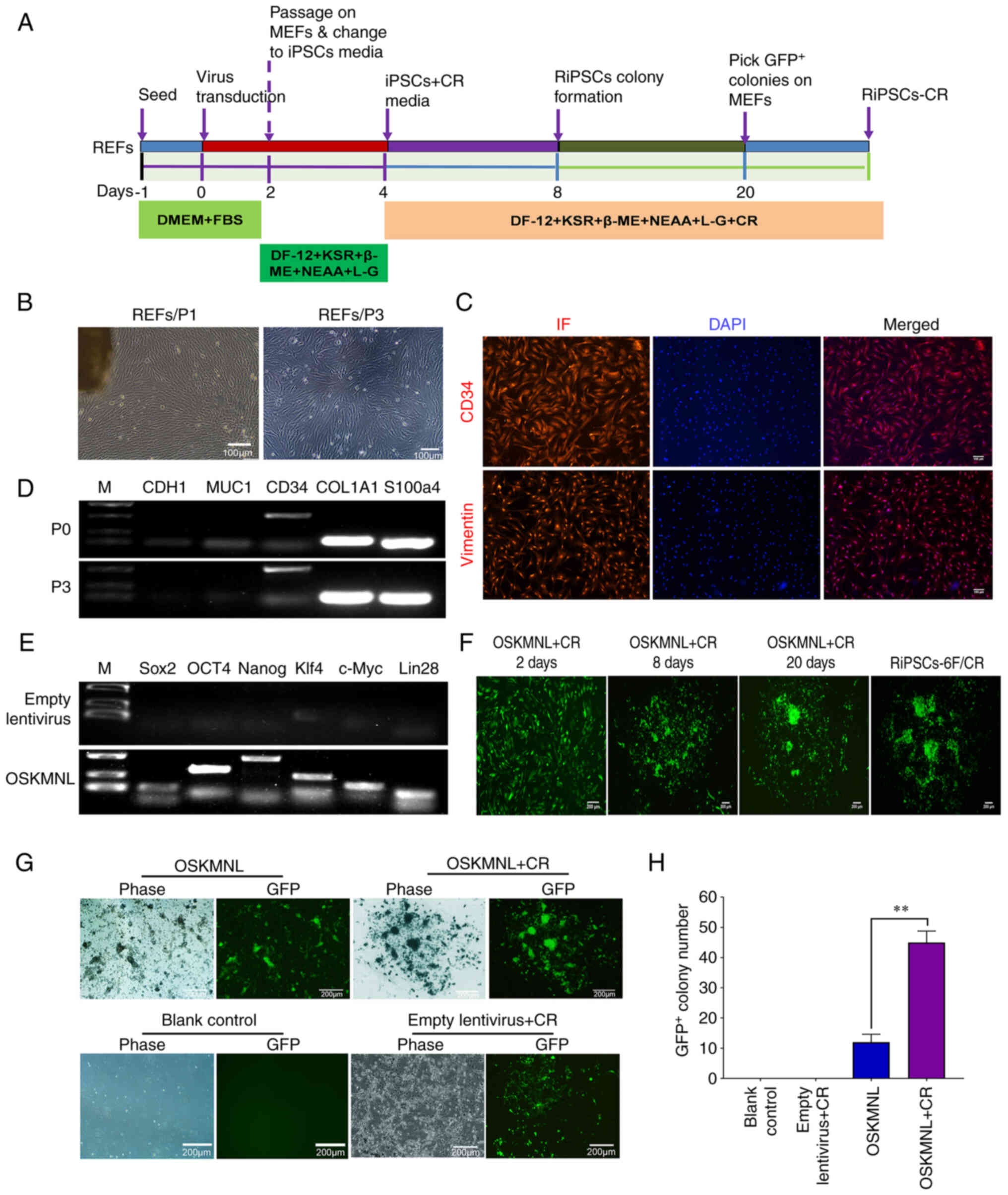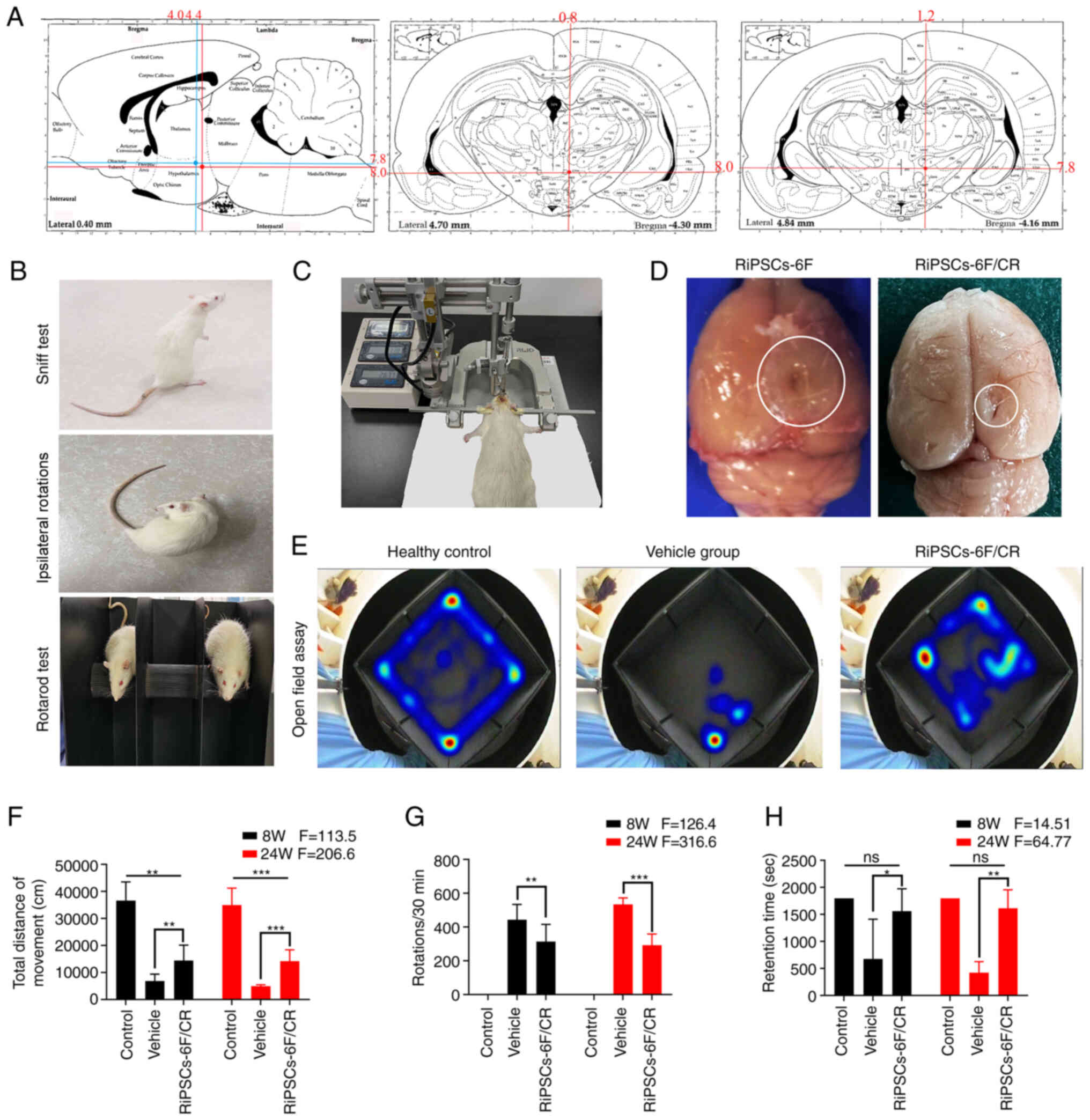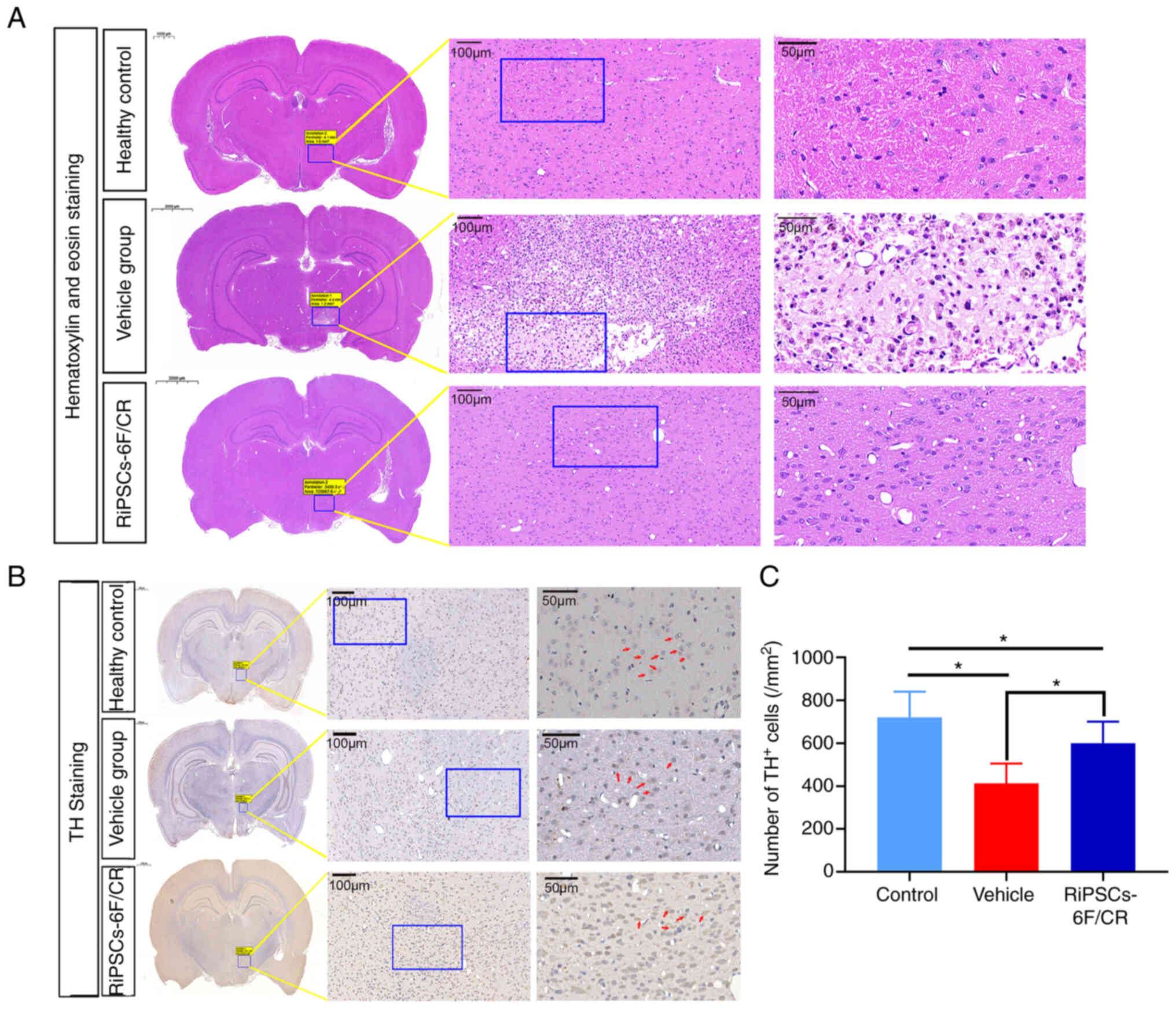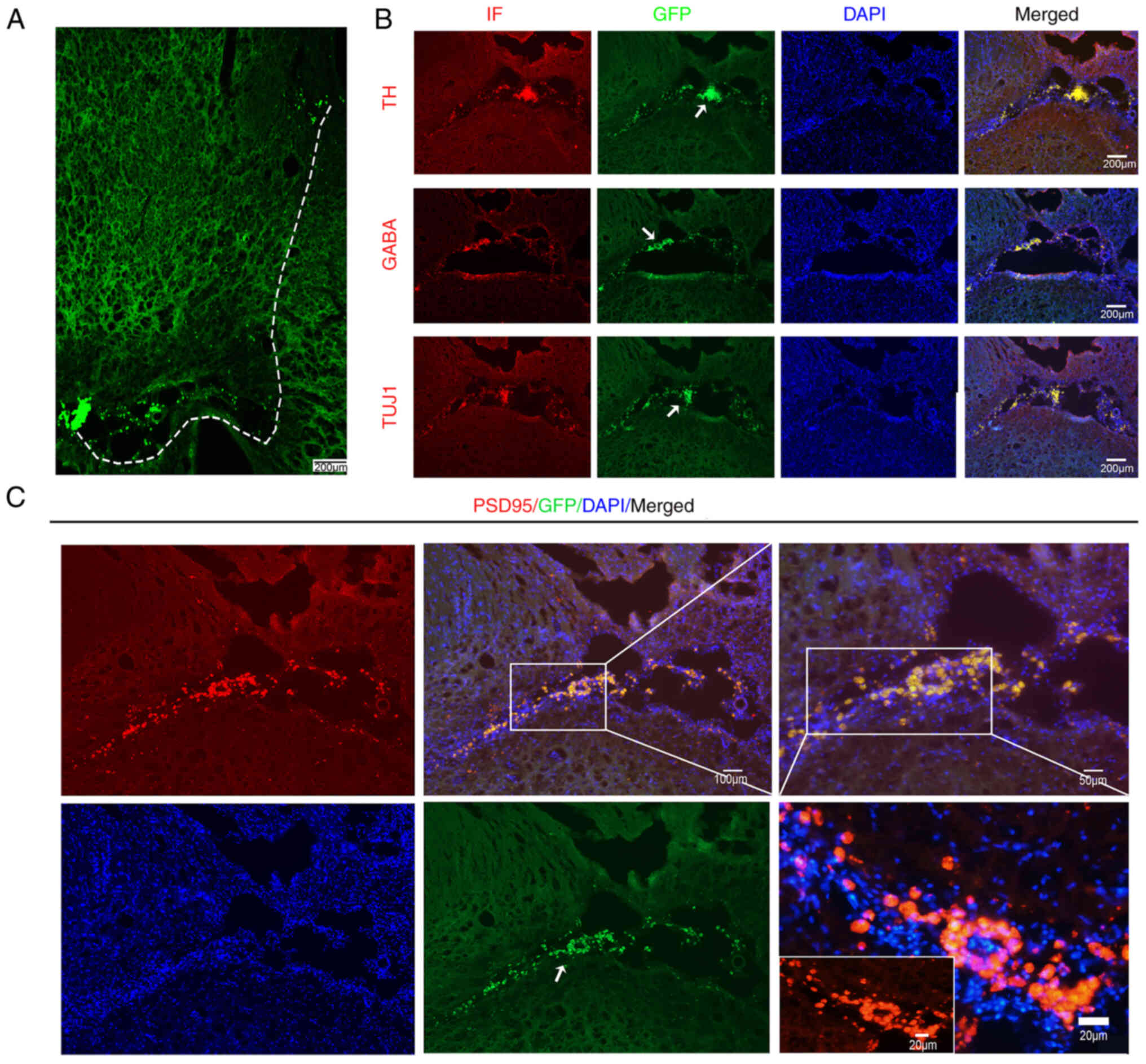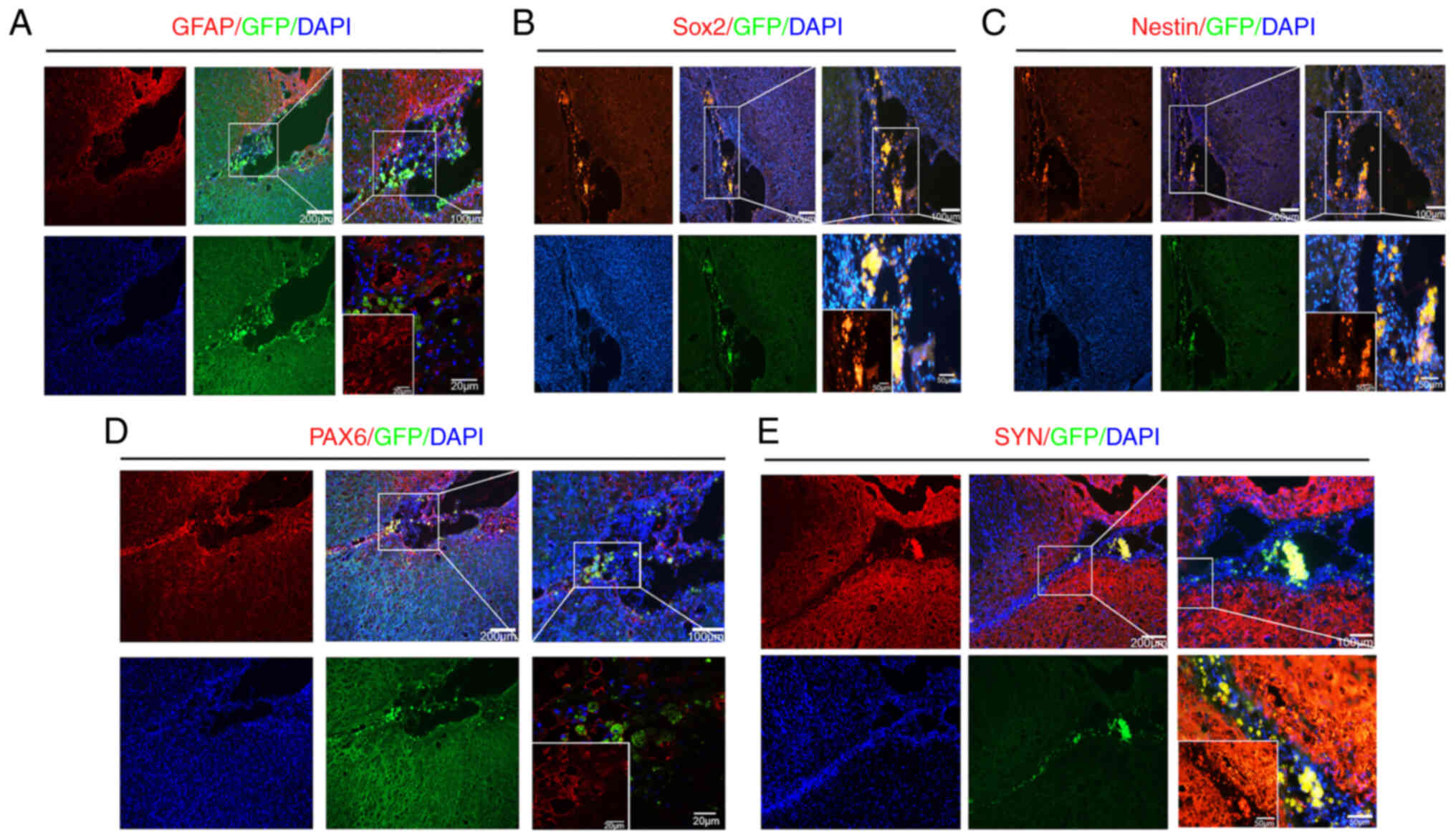|
1
|
Guo Y, Guan Y, Zhu H, Sun T, Wang Y, Huang
Y, Ma C, Emery R, Guan W, Wang C and Liu C: Therapeutic function of
iPSCs-derived primitive neuroepithelial cells in a rat model of
Parkinson's disease. Neurochem Int. 155:1053242022. View Article : Google Scholar : PubMed/NCBI
|
|
2
|
Tang Y, Meng L, Wan CM, Liu ZH, Liao WH,
Yan XX, Wang XY, Tang BS and Guo JF: Identifying the presence of
Parkinson's disease using low-frequency fluctuations in BOLD
signals. Neurosci Lett. 645:1–6. 2017. View Article : Google Scholar : PubMed/NCBI
|
|
3
|
Parmar M, Grealish S and Henchcliffe C:
The future of stem cell therapies for Parkinson disease. Nat Rev
Neurosci. 21:103–115. 2020. View Article : Google Scholar : PubMed/NCBI
|
|
4
|
Armstrong MJ and Okun MS: Diagnosis and
treatment of Parkinson disease: A review. JAMA. 323:548–560. 2020.
View Article : Google Scholar : PubMed/NCBI
|
|
5
|
Blesa J and Przedborski S: Parkinson's
disease: Animal models and dopaminergic cell vulnerability. Front
Neuroanat. 8:1552014. View Article : Google Scholar
|
|
6
|
Burke RE, Cadet JL, Kent JD, Karanas AL
and Jackson-Lewis V: An assessment of the validity of densitometric
measures of striatal tyrosine hydroxylase-positive fibers:
Relationship to apomorphine-induced rotations in 6-hydroxydopamine
lesioned rats. J Neurosci Methods. 35:63–73. 1990. View Article : Google Scholar : PubMed/NCBI
|
|
7
|
Bergman H, Wichmann T and DeLong MR:
Reversal of experimental parkinsonism by lesions of the subthalamic
nucleus. Science. 249:1436–1438. 1990. View Article : Google Scholar : PubMed/NCBI
|
|
8
|
Poewe W, Seppi K, Tanner CM, Halliday GM,
Brundin P, Volkmann J, Schrag AE and Lang AE: Parkinson disease.
Nat Rev Dis Primers. 3:170132017. View Article : Google Scholar : PubMed/NCBI
|
|
9
|
Limousin P and Foltynie T: Long-term
outcomes of deep brain stimulation in Parkinson disease. Nat Rev
Neurol. 15:234–242. 2019. View Article : Google Scholar : PubMed/NCBI
|
|
10
|
Hitti FL, Ramayya AG, McShane BJ, Yang AI,
Vaughan KA and Baltuch GH: Long-term outcomes following deep brain
stimulation for Parkinson's disease. J Neurosurg. Jan 18–2019.Epub
ahead of print. PubMed/NCBI
|
|
11
|
Karl JA, Ouyang B, Colletta K and Verhagen
Metman L: Long-term satisfaction and Patient-centered outcomes of
deep brain stimulation in Parkinson's disease. Brain Sci. 8:602018.
View Article : Google Scholar
|
|
12
|
Liu Z and Cheung HH: Stem cell-based
therapies for Parkinson disease. Int J Mol Sci. 21:80602020.
View Article : Google Scholar :
|
|
13
|
Pan T, Xu J and Zhu Y: Self-renewal
molecular mechanisms of colorectal cancer stem cells. Int J Mol
Med. 39:9–20. 2017. View Article : Google Scholar
|
|
14
|
Takahashi K, Tanabe K, Ohnuki M, Narita M,
Ichisaka T, Tomoda K and Yamanaka S: Induction of pluripotent stem
cells from adult human fibroblasts by defined factors. Cell.
131:861–872. 2007. View Article : Google Scholar : PubMed/NCBI
|
|
15
|
Aoi T: 10th anniversary of iPS cells: The
challenges that lie ahead. J Biochem. 160:121–129. 2016. View Article : Google Scholar : PubMed/NCBI
|
|
16
|
Sonntag KC, Song B, Lee N, Jung JH, Cha Y,
Leblanc P, Neff C, Kong SW, Carter BS, Schweitzer J and Kim KS:
Pluripotent stem cell-based therapy for Parkinson's disease:
Current status and future prospects. Prog Neurobiol. 168:1–20.
2018. View Article : Google Scholar : PubMed/NCBI
|
|
17
|
de Lau LM and Breteler MM: Epidemiology of
Parkinson's disease. Lancet Neurol. 5:525–535. 2006. View Article : Google Scholar : PubMed/NCBI
|
|
18
|
Takahashi K and Yamanaka S: Induction of
pluripotent stem cells from mouse embryonic and adult fibroblast
cultures by defined factors. Cell. 126:663–676. 2006. View Article : Google Scholar : PubMed/NCBI
|
|
19
|
Yu J, Vodyanik MA, Smuga-Otto K,
Antosiewicz-Bourget J, Frane JL, Tian S, Nie J, Jonsdottir GA,
Ruotti V, Stewart R, et al: Induced pluripotent stem cell lines
derived from human somatic cells. Science. 318:1917–1920. 2007.
View Article : Google Scholar : PubMed/NCBI
|
|
20
|
Chhabra A: Inherent immunogenicity or lack
thereof of pluripotent stem cells: Implications for cell
replacement therapy. Front Immunol. 8:9932017. View Article : Google Scholar : PubMed/NCBI
|
|
21
|
Tiscornia G, Vivas EL and Izpisua Belmonte
JC: Diseases in a dish: Modeling human genetic disorders using
induced pluripotent cells. Nat Med. 17:1570–1576. 2011. View Article : Google Scholar : PubMed/NCBI
|
|
22
|
Singh VK, Kalsan M, Kumar N, Saini A and
Chandra R: Induced pluripotent stem cells: Applications in
regenerative medicine, disease modeling, and drug discovery. Front
Cell Dev Biol. 3:22015. View Article : Google Scholar : PubMed/NCBI
|
|
23
|
Brevini TA, Pennarossa G, Manzoni EF,
Gandolfi CE, Zenobi A and Gandolfi F: The quest for an effective
and safe personalized cell therapy using epigenetic tools. Clin
Epigenetics. 8:1192016. View Article : Google Scholar : PubMed/NCBI
|
|
24
|
Kim J, Jeon J, Song B, Lee N, Ko S, Cha Y,
Leblanc P, Seo H and Kim KS: Spotting-based differentiation of
functional dopaminergic progenitors from human pluripotent stem
cells. Nat Protoc. 17:890–909. 2022. View Article : Google Scholar : PubMed/NCBI
|
|
25
|
Samata B, Doi D, Nishimura K, Kikuchi T,
Watanabe A, Sakamoto Y, Kakuta J, Ono Y and Takahashi J:
Purification of functional human ES and iPSC-derived midbrain
dopaminergic progenitors using LRTM1. Nat Commun. 7:130972016.
View Article : Google Scholar : PubMed/NCBI
|
|
26
|
Song B, Cha Y, Ko S, Jeon J, Lee N, Seo H,
Park KJ, Lee IH, Lopes C, Feitosa M, et al: Human autologous
iPSC-derived dopaminergic progenitors restore motor function in
Parkinson's disease models. J Clin Invest. 130:904–920. 2020.
View Article : Google Scholar :
|
|
27
|
Kikuchi T, Morizane A, Doi D, Magotani H,
Onoe H, Hayashi T, Mizuma H, Takara S, Takahashi R, Inoue H, et al:
Human iPS cell-derived dopaminergic neurons function in a primate
Parkinson's disease model. Nature. 548:592–596. 2017. View Article : Google Scholar : PubMed/NCBI
|
|
28
|
Hallett PJ, Deleidi M, Astradsson A, Smith
GA, Cooper O, Osborn TM, Sundberg M, Moore MA, Perez-Torres E,
Brownell AL, et al: Successful function of autologous iPSC-derived
dopamine neurons following transplantation in a non-human primate
model of Parkinson's disease. Cell Stem Cell. 16:269–274. 2015.
View Article : Google Scholar : PubMed/NCBI
|
|
29
|
Guo Y, Zhu H, Li X, Ma C, Sun T, Wang Y,
Wang C, Guan W and Liu C: Multiple functions of reversine on the
biological characteristics of sheep fibroblasts. Sci Rep.
11:123652021. View Article : Google Scholar : PubMed/NCBI
|
|
30
|
Shenoy S: CDH1 (E-Cadherin) mutation and
gastric cancer: Genetics, molecular mechanisms and guidelines for
management. Cancer Manag Res. 11:10477–10486. 2019. View Article : Google Scholar : PubMed/NCBI
|
|
31
|
Li M, Wang J, Wang C, Xia L, Xu J, Xie X
and Lu W: Microenvironment remodeled by tumor and stromal cells
elevates fibroblast-derived COL1A1 and facilitates ovarian cancer
metastasis. Exp Cell Res. 394:1121532020. View Article : Google Scholar : PubMed/NCBI
|
|
32
|
Foot O, Hallin M, Bague S, Jones RL and
Thway K: Superficial CD34-positive fibroblastic tumor. Int J Surg
Pathol. 28:879–881. 2020. View Article : Google Scholar : PubMed/NCBI
|
|
33
|
Zarei R, Nikpour P, Rashidi B, Eskandari N
and Aboutorabi R: Evaluation of Muc1 Gene expression at the time of
implantation in diabetic rat models treated with insulin, metformin
and pioglitazone in the normal cycle and ovulation induction cycle.
Int J Fertil Steril. 14:218–222. 2020.PubMed/NCBI
|
|
34
|
Vakhrusheva A, Endzhievskaya S, Zhuikov V,
Nekrasova T, Parshina E, Ovsiannikova N, Popov V, Bagrov D, Minin
AA and Sokolova OS: The role of vimentin in directional migration
of rat fibroblasts. Cytoskeleton (Hoboken). 76:467–476. 2019.
View Article : Google Scholar
|
|
35
|
Jia M, Qiu H, Lin L, Zhang S, Li D and Jin
D: Inhibition of PI3K/AKT/mTOR signalling pathway activates
autophagy and suppresses peritoneal fibrosis in the process of
peritoneal dialysis. Front Physiol. 13:7784792022. View Article : Google Scholar : PubMed/NCBI
|
|
36
|
Guo Y, Zhu H, Li X, Ma C, Li Y, Sun T,
Wang Y, Wang C, Guan W and Liu C: RepSox effectively promotes the
induced differentiation of sheep fibroblasts into adipocytes via
the inhibition of the TGFβ1/Smad pathway. Int J Mol Med.
48:1482021. View Article : Google Scholar
|
|
37
|
Yang Y, Wang QQ, Bozinov O, Xu RX, Sun YL
and Wang SS: GSK3 inhibitor CHIR99021 enriches glioma stemlike
cells. Oncol Rep. 43:1479–1490. 2020.PubMed/NCBI
|
|
38
|
Li X, Guo Y, Yao Y, Hua J, Ma Y, Liu C and
Guan W: Reversine increases the plasticity of long-term
cryopreserved fibroblasts to multipotent progenitor cells through
activation of Oct4. Int J Biol Sci. 12:53–62. 2016. View Article : Google Scholar : PubMed/NCBI
|
|
39
|
Casarrubea M, Sorbera F and Crescimanno G:
Structure of rat behavior in hole-board: II) multivariate analysis
of modifications induced by diazepam. Physiol Behavior. 96:683–692.
2009. View Article : Google Scholar
|
|
40
|
Li X, Zuo X, Jing J, Ma Y, Wang J, Liu D,
Zhu J, Du X, Xiong L, Du Y, et al: Small-molecule-driven direct
reprogramming of mouse fibroblasts into functional neurons. Cell
Stem Cell. 17:195–203. 2015. View Article : Google Scholar : PubMed/NCBI
|
|
41
|
Li Y, Zhang Q, Yin X, Yang W, Du Y, Hou P,
Ge J, Liu C, Zhang W, Zhang X, et al: Generation of iPSCs from
mouse fibroblasts with a single gene, Oct4, and small molecules.
Cell Res. 21:196–204. 2011. View Article : Google Scholar
|
|
42
|
Cao N, Huang Y, Zheng J, Spencer CI, Zhang
Y, Fu JD, Nie B, Xie M, Zhang M, Wang H, et al: Conversion of human
fibroblasts into functional cardiomyocytes by small molecules.
Science. 352:1216–1220. 2016. View Article : Google Scholar : PubMed/NCBI
|
|
43
|
Ma Y, Xie H, Du X, Wang L, Jin X, Zhang Q,
Han Y, Sun S, Wang L, Li X, et al: In vivo chemical reprogramming
of astrocytes into neurons. Cell Discov. 7:122021. View Article : Google Scholar : PubMed/NCBI
|
|
44
|
Cartwright P, McLean C, Sheppard A, Rivett
D, Jones K and Dalton S: LIF/STAT3 controls ES cell self-renewal
and pluripotency by a Myc-dependent mechanism. Development.
132:885–896. 2005. View Article : Google Scholar : PubMed/NCBI
|
|
45
|
Liao J, Cui C, Chen S, Ren J, Chen J, Gao
Y, Li H, Jia N, Cheng L, Xiao H and Xiao L: Generation of induced
pluripotent stem cell lines from adult rat cells. Cell Stem Cell.
4:11–15. 2009. View Article : Google Scholar
|
|
46
|
Hirabayashi M and Hochi S: Embryonic stem
(ES) cells and induced pluripotent stem (iPS) cells in rats. Reprod
Med Biol. 10:231–238. 2011. View Article : Google Scholar : PubMed/NCBI
|
|
47
|
Yasuda S, Kusakawa S, Kuroda T, Miura T,
Tano K, Takada N, Matsuyama S, Matsuyama A, Nasu M, Umezawa A, et
al: Tumorigenicity-associated characteristics of human iPS cell
lines. PLoS One. 13:e02050222018. View Article : Google Scholar : PubMed/NCBI
|
|
48
|
Fong CY, Gauthaman K and Bongso A:
Teratomas from pluripotent stem cells: A clinical hurdle. J Cell
Biochem. 111:769–781. 2010. View Article : Google Scholar : PubMed/NCBI
|
|
49
|
Doi D, Morizane A, Kikuchi T, Onoe H,
Hayashi T, Kawasaki T, Motono M, Sasai Y, Saiki H, Gomi M, et al:
Prolonged maturation culture favors a reduction in the
tumorigenicity and the dopaminergic function of human ESC-derived
neural cells in a primate model of Parkinson's disease. Stem Cells.
30:935–945. 2012. View Article : Google Scholar : PubMed/NCBI
|
|
50
|
Wei ZD and Shetty AK: Treating Parkinson's
disease by astrocyte reprogramming: Progress and challenges. Sci
Adv. 7:eabg31982021. View Article : Google Scholar : PubMed/NCBI
|
|
51
|
Duan L, Bhattacharyya BJ, Belmadani A, Pan
L, Miller RJ and Kessler JA: Stem cell derived basal forebrain
cholinergic neurons from Alzheimer's disease patients are more
susceptible to cell death. Mol Neurodegener. 9:32014. View Article : Google Scholar : PubMed/NCBI
|
|
52
|
Abdul Wahid SF, Law ZK, Ismail NA and Lai
NM: Cell-based therapies for amyotrophic lateral sclerosis/motor
neuron disease. Cochrane Database Syst Rev.
12:CD0117422019.PubMed/NCBI
|
|
53
|
Han F, Liu Y, Huang J, Zhang X and Wei C:
Current approaches and molecular mechanisms for directly
reprogramming fibroblasts into neurons and dopamine neurons. Front
Aging Neurosci. 13:7385292021. View Article : Google Scholar : PubMed/NCBI
|
|
54
|
D'Souza GX, Rose SE, Knupp A, Nicholson
DA, Keene CD and Young JE: The application of in vitro-derived
human neurons in neurodegenerative disease modeling. J Neurosci
Res. 99:124–140. 2021. View Article : Google Scholar
|
|
55
|
Ke M, Chong CM and Su H: Using induced
pluripotent stem cells for modeling Parkinson's disease. World J
Stem Cells. 11:634–649. 2019. View Article : Google Scholar : PubMed/NCBI
|
|
56
|
Schweitzer JS, Song B, Herrington TM, Park
TY, Lee N, Ko S, Jeon J, Cha Y, Kim K, Li Q, et al: Personalized
iPSC-derived dopamine progenitor cells for Parkinson's disease. N
Engl J Med. 382:1926–1932. 2020. View Article : Google Scholar : PubMed/NCBI
|
|
57
|
Tang Y and Cheng L: Cocktail of chemical
compounds robustly promoting cell reprogramming protects liver
against acute injury. Protein Cell. 8:273–283. 2017. View Article : Google Scholar : PubMed/NCBI
|
|
58
|
Zhou Y, Zhu X, Dai Y, Xiong S, Wei C, Yu
P, Tang Y, Wu L, Li J, Liu D, et al: Chemical cocktail induces
hematopoietic reprogramming and expands hematopoietic
stem/progenitor cells. Adv Sci (Weinh). 7:19017852020. View Article : Google Scholar
|
|
59
|
Lin X, Li AM, Li YH, Luo RC, Zou YJ, Liu
YY, Liu C, Xie YY, Zuo S, Liu Z, et al: Silencing MYH9 blocks
HBx-induced GSK3beta ubiquitination and degradation to inhibit
tumor stemness in hepatocellular carcinoma. Signal Transduct Target
Ther. 5:132020. View Article : Google Scholar
|
|
60
|
Guan J, Wang G, Wang J, Zhang Z, Fu Y,
Cheng L, Meng G, Lyu Y, Zhu J, Li Y, et al: Chemical reprogramming
of human somatic cells to pluripotent stem cells. Nature.
605:325–331. 2022. View Article : Google Scholar : PubMed/NCBI
|















